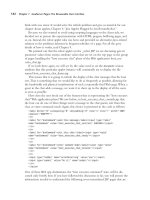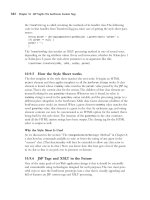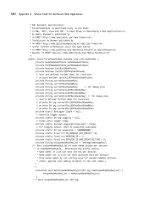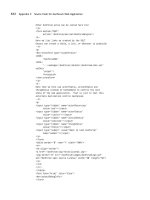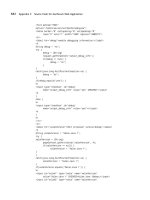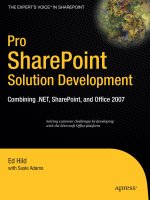Pro PHP Application Performance pptx
Bạn đang xem bản rút gọn của tài liệu. Xem và tải ngay bản đầy đủ của tài liệu tại đây (11.68 MB, 254 trang )
Pro PHP Application
Performance
Tuning PHP Web Projects for
Maximum Performance
■ ■ ■
Armando Padilla
and Tim Hawkins
Pro PHP Application Performance: Tuning PHP Web Projects for Maximum
Performance
Copyright © 2010 by Armando Padilla and Tim Hawkins
All rights reserved. No part of this work may be reproduced or transmitted in any form or
by any means, electronic or mechanical, including photocopying, recording, or by any
information storage or retrieval system, without the prior written permission of the
copyright owner and the publisher.
ISBN-13 (pbk): 978-1-4302-2898-1
ISBN-13 (electronic): 978-1-4302-2899-8
Printed and bound in the United States of America 9 8 7 6 5 4 3 2 1
Trademarked names, logos, and images may appear in this book. Rather than use a
trademark symbol with every occurrence of a trademarked name, logo, or image we use
the names, logos, and images only in an editorial fashion and to the benefit of the
trademark owner, with no intention of infringement of the trademark.
The use in this publication of trade names, trademarks, service marks, and similar terms,
even if they are not identified as such, is not to be taken as an expression of opinion as to
whether or not they are subject to proprietary rights.
President and Publisher: Paul Manning
Lead Editor: Frank Pohlmann
Development Editors: Jim Markham and Michelle Lowman
Technical Reviewer: Aaron Saray
Editorial Board: Steve Anglin, Mark Beckner, Ewan Buckingham, Gary Cornell,
Jonathan Gennick, Jonathan Hassell, Michelle Lowman, Matthew Moodie, Duncan
Parkes, Jeffrey Pepper, Frank Pohlmann, Douglas Pundick, Ben Renow-Clarke,
Dominic Shakeshaft, Matt Wade, Tom Welsh
Coordinating Editor: Jennifer L. Blackwell
Copy Editor: Mary Ann Fugate
Compositor: MacPS, LLC
Indexer: Becky Hornyak
Artist: April Milne
Cover Designer: Anna Ishchenko
Distributed to the book trade worldwide by Springer Science+Business Media, LLC., 233
Spring Street, 6th Floor, New York, NY 10013. Phone 1-800-SPRINGER, fax (201) 348-4505,
, or visit www.springeronline.com.
For information on translations, please e-mail
, or visit www.apress.com.
Apress and friends of ED books may be purchased in bulk for academic, corporate, or
promotional use. eBook versions and licenses are also available for most titles. For more
information, reference our Special Bulk Sales–eBook Licensing web page at
www.apress.com/info/bulksales.
vi
Affecting Your Benchmark Figures 20
Geographical Location 20
The Traveling Packets 20
Response Size 21
Code Complexity 22
Browser Behavior
22
Web Server Setup 22
Summary 24
■Chapter 2: Improving Client Download and Rendering Performance 25
The Importance of Optimizing Responses 27
Firebug 28
Installing Firebug 28
Firebug Performance Tabs 28
The Console Tab 30
The Net Tab 32
YSlow 33
YSlow v2 Rulesets 34
Installing YSlow 35
Starting YSlow 36
Page Speed 39
Installing Page Speed 39
Page Speed at Work
39
Optimization Tools 42
JavaScript Optimization 42
JavaScript Placement 43
Minification of JavaScript 46
Minification Tools 47
YUI Compressor 47
Closure Compiler 48
■ CONTENTS
vii
Reduce Resource Requests 49
Use Server-Side Compression 49
Image Compression 49
Smush.it 50
Summary 52
■Chapter 3: PHP Code Optimization 55
PHP Best Practices 55
The PHP Economy 57
require vs. require_once 58
Calculating Loop Length in Advance
60
Accessing Array Elements Using foreach vs. for vs. w
hile 63
File Access 64
Faster Access to Object Properties
67
Looking Under the Hood Using VLD, strace, and Xdebug 68
Reviewing Opcode Functions with VLD 69
Using strace for C-level Tracing 71
Identifying Bottlenecks 73
Xdebug 2: PHP Debugging Tool 73
Validating Installation 75
Installing the GUI-Based Tool
77
Summary 80
■Chapter 4: Opcode Caching 83
Reviewing Our Roadmap 83
The PHP Life Cycle 84
Opcode Caching Tools 86
Alternative PHP Cache 86
XCache 95
Caching with XCache 97
XCache Settings 97
■ CONTENTS
viii
eAccelerator 99
eA Settings 104
Summary 107
■Chapter 5: Variable Caching 109
Application Performance Roadmap 109
The Value of Implementing Variable Caching 110
A Sample Project: Creating the Table 112
Fetching the Records 114
Calculating a Database Fetch 115
APC Caching 119
Adding Data to Cache 120
Benchmarking APC 121
Memcached 123
Installing Memcached 124
Starting Memcached Server 124
Using Memcached with PHP 125
Summary 129
■Chapter 6: Choosing the Right Web Server 131
Choosing Which Web Server Package Is for You 132
Security and Stability Are Important to You 132
Availability of Engineers with Detailed Knowledge Is Im
portant to You 133
Your Site Is Predominantly Static Content
133
You Are Hosting in a M
anaged Service 133
You Are Using Unusual PHP Extensions
133
Usage Figures for Web Servers 133
Web Server Request Handling 134
Web Server Hardware 136
Classifying Web Servers 136
Apache HTTPD 137
■ CONTENTS
ix
Apache Daemon Command Line 138
Apache Multi-processing Modules 140
Understanding Apache Modules 141
Adding Dynamic Apache Modules 142
Removing Dynamic Apache Modules
. 143
Final Words on Apache 144
lighttpd 144
Installing lighttpd 144
lighttpd Configuration Settings 148
Comparing Static Load Content 149
Installing PHP on lighttpd 150
Nginx 153
Installing Nginx 153
Windows Installation
157
Nginx As a Static Web Server 158
Installing FastCGI PHP 160
NGinx Benchmarking 162
Summary 163
■Chapter 7: Web Server and Delivery Optimization 165
Determining the Performance of Your Web Server 166
Using ApacheTop, a Real-Time Access Log File Analyzer 166
Understanding the Memory Footprint of Your Application 168
Optimizing Processes in Apache 170
Controlling Apache Clients (Prefork MPM) 170
Optimizing Memory Use and Preventing Swapping
171
Other Apache Configuration Tweaks 172
Using .htaccess Files and AllowOverride 172
Using FollowSymlinks 173
Using DirectoryIndex 173
■ CONTENTS
x
Hostname Lookup Off . 174
Keep-Alive On 174
Using mod_deflate to Compress Content . 174
Scaling Beyond a Single Server 176
Using Round-Robin DNS 176
Using a Load Balancer 176
Using Direct Server Return . 179
Sharing Sessions Between Members of a Farm . 180
Sharing Assets with a Shared File System 181
Sharing Assets with a Separate Asset Server . 182
Sharing Assets with a Content Distribution Network . 182
Pitfalls of Using Distributed Architectures . 184
Cache Coherence Issues 184
Cache Versioning Issues 184
User IP Address Tracking 185
Domino or Cascade Failure Effects . 186
Deployment Failures 187
Monitoring Your Application 187
Some Monitoring Systems for You to Investigate . 187
Summary . 188
■Chapter 8: Database Optimization 189
About MySQL 190
Understanding MySQL Storage Engines 191
MyISAM: The Original Engine . 192
InnoDB: The Pro’s Choice 192
Choosing a Storage Engine 193
Understanding How MySQL Uses Memory 194
InnoDB vs. MyISAM Memory Usage . 194
Per Server vs. per Connection (Thread) Memory Usage 195
Locating Your Configuration File . 197
■ CONTENTS
xi
Mysqltuner.pl: Tuning Your Database Server’s Memory 197
Possible Issues with Our Example Server 201
Tuning InnoDB 202
Finding Problem Queries 203
Analyzing Problem Queries 204
Recommendations for PHP Database Applications 205
Maintaining Separate Read and Write Connections 206
Using “utf8” (Multi-byte Unicode) Character Set by Default
206
Using “UTC” Date Format 207
Summary 208
■Appendix A: Installing Apache, MySQL, PHP, and PECL on Windows 209
Installing Apache 209
Post–Apache Installation 215
Installing MySQL 216
Configuring MySQL 219
Installing PHP 222
Getting PHP5 and MySQL to Talk 223
Creating a phpinfo() Script 223
Installing PECL 224
■Appendix B: Installing Apache, MySQL, PHP, and PECL on Linux 227
Fedora 14 227
Component Versions and Locations 229
Ubuntu 10.10 230
Component Versions and Locations 231
Tasksel 231
PECL 232
■Index 233
xvi
Chapter 3 – PHP Code Optimization
We begin to jump into the PHP code within this chapter. You will learn about PHP best coding practices
when it comes to performance. You will learn about constructing a faster-running for loop, how to
include files using the optimal PHP function, and, most importantly, how to use and install VLD, strace,
and Xdebug. Once VLD and strace are installed, you will analyze Opcode, as well as the Apache C-level
processes that your PHP script requires to run. Using Xdebug on the other, we will identify bottlenecks
within the PHP code itself.
Chapter 4 – Opcode Caching
Knowing the PHP life cycle is important to optimizing, so you will learn about the life cycle within this
chapter. You will learn the steps PHP takes during a user request and identify areas where we can
optimize using Opcode cachers. You will learn how to install and configure Opcode cachers such as APC,
XCache, and eAccelerator, all the while benchmarking our before and after scripts to see the gains from
caching our Opcode.
Chapter 5 – Variable Caching
Building on the information about aching covered in Chapter 4, you will be introduced to variable
caching tools, such as Memcached, as well as using APC to store information. You will learn to install,
configure, and implement a simple example to get you familiar with the software, as well as a real-world
example using a database result set.
Chapter 6 - Choosing the Right Web Server.
Until recently there was only one game in town, anybody considering a large-scale deployment would
use the defacto standard, Apache. Recently however some new and exciting alternatives have come to
the fore. In this chapter we will look at Apache in detail, and stack it up against newcomers Lighttpd and
Nginx.
Chapter 7 - Apache Web Server Optimization
Out of the box Apache is a very capable web server package, but with a little tuning and some tricks of
the trade we can increase its performance and durability and really make it sing. In this chapter we will
also look at some of the secrets of scaling out to support higher traffic and user loads.
Chapter 8 - Database Optimization.
In most web applications, the database server plays a major role. In this chapter we will look at
optimizing the mysql database server, providing methods and tools that will allow you to keep your
system in tip top shape.
3
common: they must be installed on a web server—such as Apache, or Nginx—that is
installed on an operating system.
What Figure 1–1 also depicts is the breakdown of what is covered in the book. Each
layer within the PHP application can be optimized and is the basis of all subsequent
chapters. From the front end to the web server, this book will touch on each layer shown
in the figure, but we need a tool to measure not only how well our current, unmodified
application is performing, but also how well it’s performing once we apply the
performance enhancements to it. Apache Benchmark, as well as Siege, provides that.
Benchmarking Utilities
ab and siege belong to a group of web server benchmarking tools that provide statistics
on how well a web server responds during varied simulated user requests. They allow us
to simulate any arbitrary number of users requesting a specific web document on a web
server and, most importantly, allow us to simulate a simultaneous visit by any number of
users (concurrent requests) to a hosted document on a web server.
For example, each tool provides information about the following:
• Total time a single request took to respond
• Total response size from the server
• Total number of requests a web server can handle per second
What these tools do not do is test functionality. These tools only test requests for a
single web document running on a specific web server.
ab and siege were chosen for the following reasons:
• Easy to use: Both ab and siege have only one line to type with a small
number of options to use. This means there’s a low learning curve in
getting started.
• Easy installation: Both are extremely easy to install, and require
minimum setup time.
• Command-line based: Most developers use a command line on either
a Unix or Windows server.
Defining the Request/Response Lifecycle
Let’s take a quick dive into what a HTTP request/response does by examining its lifecycle.
First, we need to understand what an HTTP request is and what an HTTP request does,
since it is the request’s lifecycle that these tools use to help measure the performance of
your application.
5
ab also allows you to run many different load simulations, such as the following:
• Simultaneous requests to a web document
• Requests over a specific amount of time
• Requests with Keep-Alive turned on
Most importantly, Apache Benchmark works independently of the Apache web
server, allowing you to run ab while having the web server inactive on the machine you
are running the tool from.
Installing Apache Benchmark
In the next two sections, we’ll go over how to install the required files to run the ab tool on
both Windows as well as Unix-based systems.
Unix and Mac Installation
If you’re on a *nix OS, you have many options to install Apache. You can install from
ports, yum, apt-get, or simply download the source and install. The complete list of
installation commands is shown in Table 1–1.
Table 1–1. Installing Apache Web Server Using Repository
Repository Command
y
um
yum install apache2
ports
sudo port install apache2
apt-get
apt-get install apache2
Mac users can use MacPorts and execute the ports-based command shown in Table
1–1 within a terminal.
Windows Installation
Windows users can open a browser and load the URL, Once
the page loads, click the “Download from a mirror” link on the left-hand side of the page,
locate the appropriate download package for your system, the Windows 32 Binary
version, and download. At the time of writing, the most current version of Apache is 2.2.X.
Once the package downloads, go ahead and install the software anywhere on your
system by running the installation wizard. I installed Apache in the default location,
C:\Program Files\Apache Software Foundation, but you can install anywhere on your
CHAPTER 1 ■ BENCHMARKING TECHNIQUES
6
system. The location you choose here will be the APACHE_HOME reference going forward.
Now, open the directory <APACHE_HOME>\Apache2.2\bin. You should see a collection of
files and directories similar to Figure 1–3.
Figure 1–3. Windows Apache installed bin directories
You have successfully installed the ab tool—now let’s use it.
Running Apache Benchmark
The first benchmark test we’re going to run is a simple test on the domain
www.example.com. The main purpose of the initial test is to get you familiar with the syntax
of the tool, review all the available options, and review a complete response.
The makeup of all ab commands follows this structure:
ab [options] [full path to web document]
Using the ab syntax, we are going to simulate a single request. Open a command/shell
terminal and type the following:
ab –n 1
The command shown utilizes a single option within the options section, the number
of requests to perform on the URL specified using the flag n. In this example, the total
number of requests allows ab to request the web document once, though the value of n
can be any arbitrary number lower than 50,000. By default, n is set to 1.
CHAPTER 1 ■ BENCHMARKING TECHNIQUES
7
The next section of the command is the URL section. Referencing the ab command
you just executed, the URL is If we had chosen to test a
document such as test.php (does not exist) within the domain, the URL to test would
have been instead.
Let’s return to the command/shell terminal used to execute the ab command. By now
you have executed the command, and your screen is full of numbers and general data
returned by the ab tool. You should have an output similar to Figure 1–4.
Figure 1–4. ab response for the URL
■ Caution When testing other machines, please be courteous and limit both the amount of requests made to
the web server and your testing. You don’t want to harm any unsuspecting servers and get into real trouble.
Making Sense of the Response
If you’ve never seen the response in the output just shown, or even if you have, the
response can be a bit overwhelming. We’re going to point out the important items for us
and the items that will let us know how well we are doing while optimizing our code
throughout the book.
Referring back to Figure 1–4, the data is broken into four major sections, shown in
Figure 1–5.
CHAPTER 1 ■ BENCHMARKING TECHNIQUES
8
Server Information
Document Information
Connection Information
Connection Metrics Breakdown
Figure 1–5. Sections of an ab result
Server Information
The server information section contains the software the web server is running. In our
example, it’s the software Apache version 2.2.3. The data is contained in the first field,
Server Software. The value for this field can change depending on the web server
software the web site is using. The value for this field might also return something you’re
unfamiliar with, due to security practices web administrators use.
The next two fields, Server Hostname and Server Port, contain the hostname we ran
our simulation on and the port number the web server is listening on.
CHAPTER 1 ■ BENCHMARKING TECHNIQUES
9
Script Information
The second section of an ab response contains information concerning the web
document the simulation ran against. Document Path contains the document that was
requested, while Document Length contains the sum of all HTML, images, CSS, JS, and
anything within the response in bytes.
Connection Information
The Connection Information section contains the bulk of the information. It answers
questions such as, “How long did a request take to receive a response?”, “How much data
was returned?”, and most importantly, “How many users can the web server support
when processing the document?”
Table 1–2 provides a complete list and description of data for this section. For now,
let’s focus on the highlighted rows, which contain the fields that matter most to us
throughout the book.
Table 1–2. ab Response Description
Field Description Example Value
Concurrency Level Total number of concurrent requests made
1,2,3,…,n, where n is
any arbitrary number
Time taken for tests Total time taken to run 000.000 seconds
Complete requests
Total number of requests completed out of the total
requests simulated
1,2,3,…,n, where n is
any arbitrary number
Failed requests
Total number of requests that failed out of the total
requests simulated
1,2,3,…,n, where n is
any arbitrary number
W
rite errors
Total number of errors encountered while using
w
riting data.
1,2,3,…,n, where n is
any arbitrary number
Non-2xx responses
Total number of requests that did not receive a HTTP
Success response (200)
1,2,3,…,n, where n is
any arbitrary number
Total transferred
Total data transferred in response for entire
simulation—size includes Header data.
725 bytes
HTML transferred
Total size of the content body transferred for the
entire simulation
137199 bytes
Requests per second Total number of requests supported per second 5.68 [#/sec] (mean)
Time per request Total time taken to satisfy a single request 176.179 milliseconds
Time per request
Total time taken to satisfy a single request across all
concurrent requests
176.179 milliseconds
Transfer rate Total number of Kbytes received per second 766.27 [Kbytes/sec]



